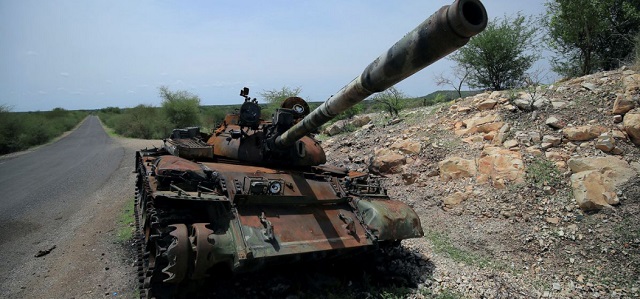
Reforming the federalist structure
Having controlled all facets of state power incontestably for the twenty-eight years prior to its ouster in 2018, the TPLF views Abiy’s democratic reforms and liberalisation zeal with a great deal of edginess. His interest in reforming the federalist structure of the Ethiopian state—which divides Ethiopia into nine self-governing ethnic territories—especially threatens to undermine the order that has historically permitted the small Tigrayan ethnic group to wield a power disproportionate to its population. Abiy is an Oromo by origin, and thus a member of Ethiopia’s largest ethnic group, and his espousal of a broader nationalist agenda over narrow ethnic priorities is viewed by many of the smaller ethnic groups, and not only the TPLF, as eroding the right to self-rule, including secession, that is granted by the Ethiopian Constitution to ethnically organised regions. The TPLF is also uneasy with Abiy over his intentions to amend the Constitution, which provides the basis of the current ethnic federalism.
Meles Zenawi, a founding member of the TPLF, created the Ethiopian constitution in the earliest days of his rule and the group’s present leaders sanction the constitution as a canonical text. They consider Abiy’s constitutional reform agenda as a ‘red line.’
The system of ethnic federalism under the EPRDF had privileged the TPLF as first among equals in a coalition government, according it an oversize share of political and economic power relative to its population size of 6 percent. Amending the constitution to redistribute power in proportion to population size would significantly reduce the TPLF’s share of power, which is something that Mekele is not prepared to concede.
Ethio-Eritrea rapprochement
Lastly, Mekele remains highly suspicious of the 2018 Ethio-Eritrea rapprochement, which included the signing of a peace agreement and a promise by Abiy to honour a long-violated United Nations ruling on the demarcation of the border between Eritrea and Tigray. Rivalry between Eritrea’s ruling party, the People’s Front for Democracy and Justice (PFDJ), and formerly known as the Eritrean People’s Liberation Front (EPLF) and the TPLF runs deep, dating back to their time in the bushes fighting the Derg. Both Addis Ababa and Asmara stand hostile to the TPLF, albeit for different reasons. Abiy’s cozying up to Asmara without including Mekele is viewed as forsaking Tigray in favour of Eritrea. Consequently, the TPLF accuses Asmara of siding with Abiy to attack Tigray in an effort to settle old scores. Despite TPLF claims to the contrary, however, there was initially no evidence of PFDJ action in this war. This is far from saying Eritrea would not retaliate if provoked.
International analysts may be right to fear that, if extended indefinitely, the present conflict may possibly rouse discontented TPLF surrogates in various pockets of Ethiopia to rise against the Abiy government. In the meantime, however, the declaration of war seems to have the opposite effect. Media accounts suggest the rest of the country is galvanized behind what the Prime Minister describes as a ‘rule of law operation’ to guarantee peace and stability and to bring a group that is widely perceived as the perpetrators of instability to justice. Certain ethnic groups along the border could also specifically benefit from the conflict. Amharas living in areas bordering Tigray, for example, harbour territorial claims over land illegally annexed by the TPLF while it assumed power. Such groups have been drawn into the present conflict on the side of the government and are already celebrating the recapture of annexed territory.
On July 19 Tigrayan forces mounted attacks in neighbouring Afar region marking an expansion of an eight-month-old conflict into a previously untouched area. The Afar were initially among ethnic groups along the border seen as likely to benefit from the conflict by reclaiming territory allegedly illegally annexed by the TPLF while it assumed power.
The breakout in fighting comes at a time when Ethiopia is contemplating several sweeping reforms. But the four years since the TPLF was ousted from power have not been long enough for Abiy’s brand of politics, and his transformational agenda, to set down firm roots.
The democratic opening he has unleashed is yet to fully address the many ethnic grievances that were bottled up under the TPLF, and sporadic ethnic flare-ups continue to occur across the country, even as the region struggles to cope with rising COVID-19 infections rates with consequential impact on economic and social life. The security forces now under Abiy’s control have been accused of not responding appropriately to many of these conflicts.
Lastly, Ethiopia remains in the midst of protracted negotiations with Egypt and Sudan over the Grand Renaissance Dam. Days before the breakout of hostilities in 2020, negotiations were taking place attended by water ministers from the three countries and experts from the African Union, European Union, and the World Bank.
The war in Tigray is unfortunate and could have tragic consequences, almost certainly including the loss of innocent lives. It is important for both sides to take extra measures to protect civilians.
Abiy’s protestations that this is a war against the TPLF and not the people of Tigray will be credible only if the government also ensures the safety and wellbeing of Tigrayans in other parts of the country. Many are not at all affiliated with the TPLF or the war efforts, but they may yet be subjected to unwarranted reprisals. But as of now, at least, concerns that Eritrea may be drawn into the war, or that the war may escalate into a regional conflict, are unfounded, or premature at best.
 The Independent Uganda: You get the Truth we Pay the Price
The Independent Uganda: You get the Truth we Pay the Price


